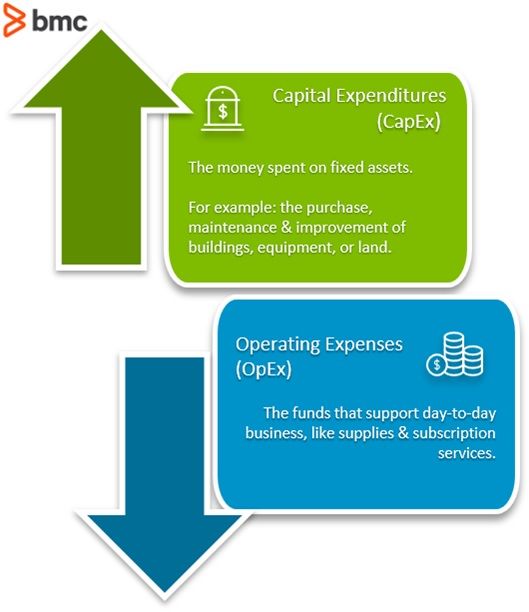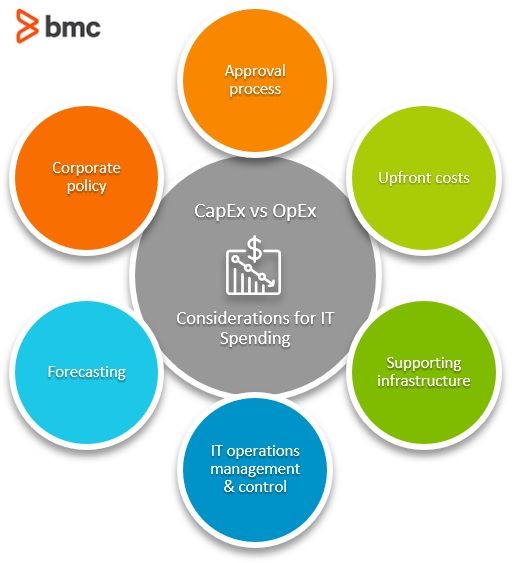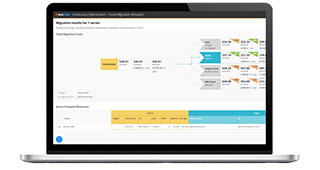When it comes to procuring new equipment, capabilities, and software, IT professionals generally have two options:
- Obtaining new capabilities and equipment as a capital expenditure (CapEx).
- Obtaining them as an operating expense (OpEx).
As many companies shift from traditional hardware and software ownership to as-a-service models, IT and finance departments must reconcile how best to classify cloud costs.
According to Gartner, after a decline in IT spending in 2020, spending has picked up significantly in 2021. Experts project that worldwide IT spending will increase 6.2% to total $3.9 trillion.
In other words, IT spending is big business. The way companies think about it may deserve new consideration. In this article, we will:
- Define CapEx and OpEx in relation to IT spending
- Compare when to use each
- See how CapEx & OpEx plays out in a real IT purchase
- Explore recent changes that seem to favor OpEx
- Share additional resources
(Note: This articles discusses CapEx and OpEx purchasing in the United States. The points and ideas discussed may be different in other countries.)

(This article is part of our IT Cost Management Guide. Use the right-hand menu to navigate.)
What are capital expenditures (CapEx)?
Capital expenditures (CapEx) refers to the money a company spends towards fixed assets, such as the purchase, maintenance, and improvement of buildings, vehicles, equipment, or land. You might also hear this called PP&E, short for property, plant, and equipment.
One-time purchases of these major physical goods or services are intended to benefit the organization for more than one year. In the IT world, examples of these major items include:
- IBM Power systems
- Intel-based Windows servers
- Other high-dollar items
- A variety of supporting items such as Universal Power Systems (UPS), line printers, air conditioners, scanners, and generators
- Additional procurement costs
(Explore IT infrastructure & components that might fall into this category.)
CapEx spending has pros and cons from the accounting side. If the asset’s useful life extends beyond a year, which is typical, the cost is expensed using depreciation, anywhere from 5-10 years beyond the purchase date.
Real estate, in particular, can be depreciated for over 20 years—something that has fueled commercial real estate for decades. Finance teams and bookkeepers applaud these CapEx tax depreciations.
On the other hand, the more money you spend on CapEx means less free cash flow for the rest of the business, which can hinder shorter-term operations.
Unlock the potential of IT Service Management with BMC Helix ITSM. ›
What are operating expenses (OpEx)?
Operating expenses (OpEx) are the funds that support your day-to-day business. OpEx items are generally used up within the year they are purchased. Examples include:
- Consumables such as printer cartridges, paper, electricity, and other supplies
- Contract items such as yearly service or maintenance agreements, website hosting, and web domain registrations
OpEx purchases cover pay-as-you-go items that show up on an organization’s profit and loss statement, and they are deducted from income as they occur.
When material goods or services are purchased as an OpEx item, the workflow is this:
- Costs are assigned to the operating expense budget.
- The expense is tracked in your profit and loss statement
- The equipment’s monthly expenses are tracked and deducted from the bottom line as they are incurred (instead of being depreciated over several years).
Management is often tasked with decreasing OpEx spending without blunting the firm’s ability to compete or produce.
Unlike the depreciation of CapEx, OpEx are fully tax-deductible in the year they are made.
Expense vs expenditure
A technical note on terms in this article. You might notice that we use “capital expenditure” and “operating expense”, instead of calling both expenditures or both expenses.
From an accounting perspective, expenditures are the payments you make on long-term spending. Expenses generally refer to more short-term spending. However, unless you’re talking to the company bookkeepers, most folks won’t notice the difference.
Determining CapEx vs OpEx
Though the definitions seem clear cut, there are plenty of grey areas. Many IT material goods—like servers, generators, or UPS systems—can be purchased either as a capital item or as an operating expense item.
For example:
- CapEx. You can pay cash and own the item outright.
- OpEx. You can lease the item or sign a hosting contract with a managed services provider (MSP) that provides access to the equipment as a service for a monthly cost.
Having the choice between CapEx and OpEx for acquiring new IT capabilities isn’t a novel development. These options have been with us in various shapes and forms for a long time. So, what’s different today?
The cloud. With new cloud hosting capabilities, using OpEx procurement to obtain major IT equipment and services is easier than it’s ever been.
Comparing CapEx vs OpEx for IT
Outside of the tax and payment treatments, there are several advantages and disadvantages to procuring major IT capabilities as either CapEx or OpEx items.
Let’s look at an example of upgrading or purchasing a new IBM Power system, and how the process differs when procuring it as either a capital expenditure or as an operating expense.
Here are different components to consider when deciding:

Approval process
CapEx and OpEx items go into different budgets, with different approval processes:
- Capital items generally must be approved through several layers of management (including executive management), which will hold up purchasing until approval is received, which could slow you down significantly.
- Adding the IBM Power system as an OpEx item is generally an easier process, as long as the item is covered through and budgeted for in the operating expense budget.
Upfront costs
For a capital purchase, all money must be paid up-front.
Purchasing IBM Power capability on lease or from a hosting company as an OpEx item allows you to pay as you go, on a monthly or quarterly basis. This can free up budget dollars for more bottom-line revenue producing projects.
Supporting infrastructure capabilities
Purchasing an IBM Power machine as a CapEx item may also require you to buy several other supporting capabilities, including:
- Redundant power supplies
- UPS systems
- Generators
- Air conditioning
- Insurance
- Maintenance
- Data center access, in order to run it all
Procuring the same capability as an OpEx item under a hosting contract will usually include all the infrastructure items that go along with your hardware. This allows you to pay for the infrastructure along with the hardware, in one regular payment.
Shifting IT operations to an outside vendor
When purchasing an IBM Power system, you as the purchaser are responsible for all IT Operations management (ITOps) capabilities, including backups, operating system upgrades, and repairs.
- In a CapEx environment, you need to provide these capabilities. All IT Ops capabilities remain with you—the buyer.
- In a hosted OpEx environment, you can include these items in your contract, so that the provider will handle them as part of your monthly service.
Forecasting
Purchasing a capital item requires a certain amount of forecasting. IBM Power systems may be purchased on a four-year lifecycle, with the intent of replacing or upgrading the machine every four years.
That means when you purchase the machine you would need to buy it with all the capabilities you believe you’ll need for a number of years into the future. You’ll need to either:
- Overbuy the machine with capabilities you may not use until the 4th year.
- Purchase additional capabilities as you need them.
If you have a cyclical business where you have significantly busier months than others (think Christmas rush for retail), then you must size your machine to have the capability to always run at peak performance, even during the slow times of your year.
With OpEx hosting, you may be able to:
- Contract for additional CPU and memory on an as needed basis.
- Run with lower capabilities the rest of the year, possibly reducing your costs.
Hardware control
In a CapEx situation, you own the hardware and have total control over its use, location, and disposition.
If you are procuring an IBM Power system as an operating expense item in the cloud, you are dependent on the hardware, operating system software, and maintenance the cloud service is providing.
You may have problems if your cloud provider:
- Has an outage
- Doesn’t have sufficient capability to meet your needs
- Is unable to meet your service level agreements (SLAs)
- Goes out of business
In OpEx situations—especially with cloud providers—you introduce a third-party into the provisioning of your IT capabilities, which can affect your performance and deliverables.
(Understand whether vendor lock-in applies to your vendor relationships.)
Corporate policy
Many organizations specify that all major IT goods or services be purchased, and they cannot be leased or “rented” through an MSP. Other organizations may specify the opposite.
The point here isn’t whether one is better than the other. Instead, it’s that you may not even have a choice on CapEx vs OpX. A particular procurement method may be mandatory depending on your organization’s rules.
Changes in IT spending that favor OpEx
Traditionally, CapEx has two significant benefits, aside from the financial positives:
- A company will own the product outright, so you can alter and tweak it as you need—once owned, you don’t continue paying for it.
- Owning assets such as hardware and software may be seen as prestigious.
Despite these benefits, three complaints of CapEx continually rise to the top:
- High-cost items require well-forecast budget estimates and long processes for approval, which can slow down purchase of the equipment.
- Age is a significant factor. Once you own the hardware or software, you’re likely stuck with it for a long time, in order to extend its ROI.
- Estimating future capacity needs for static hardware or software can be tricky and complicated.
As IT is imperative for any business operating today, two major changes have affected both hardware and software.
Today, hardware is frequently significantly cheaper to purchase than it once was, which we expect with time.
Further, though you might need highly specialized (expensive) machines in certain areas/departments, many employees can perform their daily functions on basic, low-cost computers like Dell laptops or Chromebooks, since so much work has shifted to the cloud.
So, what does this mean for OpEx? In the cloud era, companies who used to avoid significant operational expenses might be embracing them, particularly for these benefits:
- More cost-effective & flexible
- Less red tape
- Scalability
More cost-effective & flexible
The internet makes software a lot nimbler—and more cost-effective.
Instead of purchasing expensive licenses to own and alter software in a CapEx model, companies can shift towards as-a-service options, including SaaS, IaaS, PaaS, AIaaS, and even IT as a service.
These options:
- Run via internet connection, generally eliminating any manual install or upgrade.
- Require small, monthly subscriptions, often per user.
- Offer transparency, letting companies pay only for pieces they use.
- Fall under the OpEx procurement model, with all its inherent benefits.
Less red tape
With low monthly costs, budget approval of OpEx procurement can be a lot speedier, reducing the time needed to achieve business goals.

The monthly payment model of software as a service (SaaS) and related services can help streamline business cash flow over time: there’s no long-term commitment. That’s good for:
- Turning off services when you don’t need them
- Switching to a new product when one product stops fitting your needs.
The minute one SaaS option doesn’t work, a department could—realistically, easily—switch to another one that better suits their needs. This flexibility is key for emerging opportunities.
Scalable
Not every operating expense is scalable, but SaaS sure is! If you need to add many users only for a month, SaaS is still cheaper than outright owning software for that many users.
Importantly, SaaS and similar solutions make it much easier to measure ROI—is the cost justifying the benefits? It’s usually harder to track ROI on a lump-sum purchase of a product that continues to age than it is on a monthly payment under a SaaS arrangement.
With these changes in cost and use of hardware and software options, the traditional benefits of CapEx may not carry their weight. Using an OpEx solution like SaaS allows organizations to unlock money that was formerly frozen in CapEx purchases on other business needs.
Will OpEx outpace CapEx?
Still, the complaints of CapEx do not mean that OpEx is the ultimate solution for every company or every purchase.
Some companies worry that they don’t know what to expect and instead wind up budgeting their IT needs on a month-to-month basis. If use is low one month, but skyrockets the next, long-term forecasting is complicated.
Justifying a switch from CapEx to OpEx can also be difficult, as CIOs, CTOs, and the finance department appreciate the tax benefits of CapEx. Many C-level execs and financial departments prefer stable payments over fluctuating monthly payments.
Fortunately, more SaaS providers are addressing these OpEx concerns. When the cloud first became feasible, a giant hindrance was the lack of transparency into costs. Forgetting to turn off an AWS instance, for example, could cost you dearly.
Fortunately, SaaS and other cloud providers are adjusting to these concerns. Increasingly, cloud environments can predict or limit—often automatically—these costs.
As cloud technology continues to develop, it will get smarter in its usage predictions, ensuring that monthly costs don’t go through the roof.

CapEx, OpEx: which is right for you?
The good news is that selecting CapEx or OpEx is not an either/or situation.
Companies need to choose which areas to bucket under CapEx and which to bucket in OpEx, understanding the trade-offs. Perhaps some enterprise systems must be owned outright and in-house, while other applications can come and go as the need and staff change.
- Proper forecasting can help a company invest as necessary in CapEx, while accurately estimating OpEx.
- Experts also recommend considering the non-monetary cost of the transaction. This can include the friction users feel when switching from one type of technology to another, common in a CapEx/OpEx tradeoff.
Keeping in mind the pains of forecast and change, remember that the benefit of considering CapEx/OpEx for IT spending is about shifting money spending to better benefit overall business needs.
Regardless of what expense model you choose, having the visibility and control of your infrastructure—whether in a CapEx model on premises or an OpEx model in public or private clouds—gives you the ability to make decisions that will impact your overall business success.







